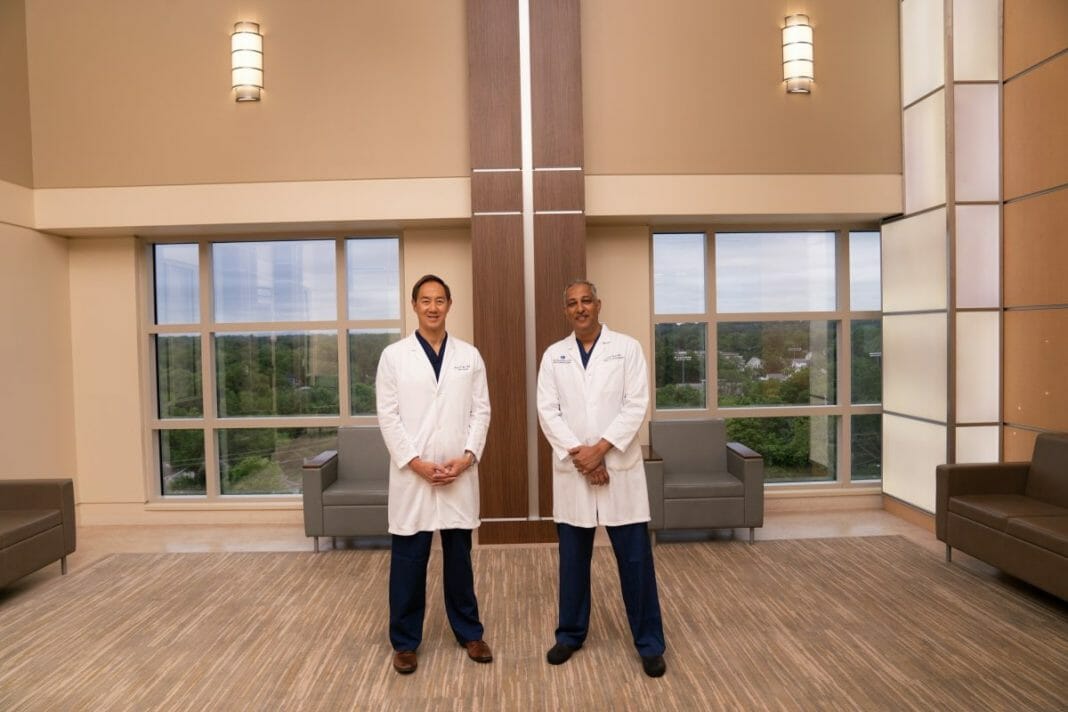Englewood Health has become the first hospital in New Jersey and one of only 20 hospitals in the country to introduce new advanced technology for robot-assisted spine surgery with GPS-like precision to improve spine surgery. The Excelsius™ Ecosystem is a robotic imaging and navigation platform that will enhance patient safety, improve accuracy and efficiency, and enable minimally invasive surgery.
“This technology takes us to the next era of spine surgery,” says Kevin Yao, MD, chief of neurosurgery at Englewood Health. “It facilitates more precise and more minimally invasive spine surgery, which will translate into shorter patient recoveries and better outcomes.”
Spine surgery is frequently used to stabilize vertebral bones and spinal joints and relieve pressure on the nerves in the spine. Traditionally, spine surgery is performed either percutaneously (minimally invasive surgery) or open and requires several types of imaging equipment for procedures. The new technology gives surgeons an all-in-one imaging capability allowing enhanced visualization of the patient’s anatomy. The Excelsius Ecosystem (Globus Medical) combines the Excelsius3D™ imaging system and the ExcelsiusGPS® robotic navigation platform to provide surgeons with a comprehensive intraoperative image-guided robotic surgery tool.
At Englewood Health, spinal procedures such as lumbar or thoracic fusion will now be possible with more minimally invasive, highly precise techniques. Patients with spine conditions such as degenerative disc disease, fractures, scoliosis, spinal stenosis, and spinal tumors will benefit from newly enhanced procedures made possible by robotic navigation technology. The application of this technology is expected to expand for use in other spine procedures.
To be successful, spinal surgery requires highly accurate placement of surgical hardware used to hold vertebrae. The ExcelsiusGPS generates real-time information before and during the procedure, allowing surgeons to use robotic navigation to place screws and rods with a high-level of precision anywhere from the cervical to the sacroiliac spinal regions.
“Robot-assisted navigation can also help increase predictability of outcomes,” says Asit K. Shah, MD, PhD, chief of orthopedic surgery at Englewood Health. “It is like a GPS for the spine, which gives surgeons a very precise way to choose exactly where to place surgical hardware, such as metal screws.”
Dr. Yao adds, “Many spine surgeries that traditionally required large incisions can now be performed through slit-like openings. This is beneficial for patients, allowing them to mobilize more comfortably and sooner.”
The Excelsius Ecosystem combines a robotic arm and full navigation capabilities into a single platform for accurate trajectory alignment in spine surgery. The new technology brings a greater level of precision to surgeons performing spine surgery and reduces imaging requirements before, during and after surgery, therefore reducing radiation exposure for the patient and staff.
Radiology images are taken on the day of surgery and imported into the Excelsius equipment. The surgeon then uses these images to determine the size and placement of implants and create a patient plan based on the patient’s anatomy. That plan is used by the surgeon to guide the robotic arm to a specific region of the spine and follow a pathway, like following a GPS. During the procedure, surgeons view live images and the established pathway to accurately place the implants using surgical instruments. The accuracy of hardware placement is then confirmed by 3D image before the patient leaves the operating room.
Beyond greater accuracy and safety, the Excelsius Ecosystem allows for improved surgical efficiency. Additionally, with enhanced visualization, more spinal procedures can now be performed minimally invasively, which means smaller incisions, less tissue damage, reduced post-operative pain, shorter hospital stays, and faster returns to activity.
